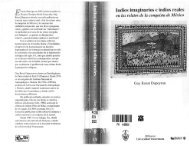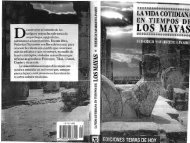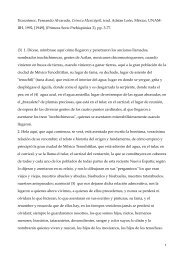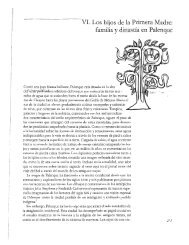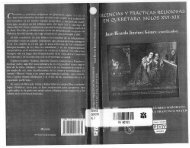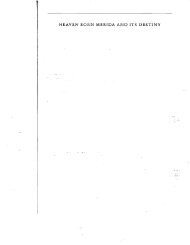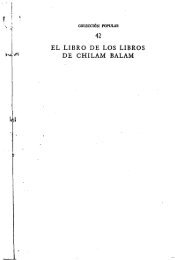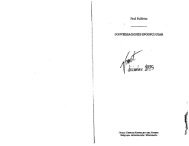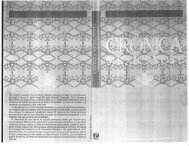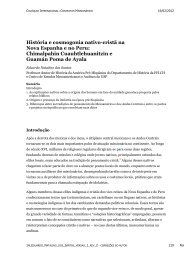1 - Histomesoamericana
1 - Histomesoamericana
1 - Histomesoamericana
Create successful ePaper yourself
Turn your PDF publications into a flip-book with our unique Google optimized e-Paper software.
^s 1<br />
invented in Mayapan, and was<br />
the beginning of the decline of<br />
the Itza and Xiu matrilineages,<br />
the beginning of the end of the<br />
legitimate nobility. (1570)<br />
There used to be three pyramids<br />
at Akab P'ix, now in ruins<br />
near Yaxche. It was all moved<br />
FIVE AHAU 71<br />
Hi u ch'abal<br />
Katun la e*<br />
Mayapan u u ich<br />
U kex katun<br />
T u kin*<br />
U y emel<br />
Y al kuk<br />
Y al yaxum*<br />
T u kin i<br />
Uil*<br />
Chibil al<br />
Chibil mehen*<br />
T u kin y an ox muí tun tzek*<br />
Pail Akab Ppix*<br />
Ich ox nublan cot<br />
Ox tz'alab u nak Yax Che*<br />
That was the creation<br />
1560 Of this katun.<br />
Mayapan was the face<br />
Of the change of the katun,<br />
In the sun<br />
Of the decline<br />
1565 Of the quetzal born,<br />
The blue bird born,<br />
In the sun<br />
And moon<br />
Of the born heirs<br />
1570 And engendered heirs.<br />
In the sun there were three ruins,<br />
The stone walls of Akab P'ix,<br />
In the three collapsed walls,<br />
The three slabs near Yaxche.<br />
(note continued from preceding page)<br />
with 1 Pop rather than 0 Pop. This was the consequence of the calendar reform<br />
opportunely inaugurated at Mayapan in 1539, when the relevant Mayan cycles<br />
were in a conjunction almost uniquely favorable to such a change. See Edmonson<br />
1976.<br />
1560. That is, the inversion of the naming of the katun is responsible for the<br />
dating system now in use. The author is specifying which calendar he wants to<br />
use: that of Mayapan.<br />
1563. In the sun: at the beginning.<br />
1566. In a number of other passages the quetzal and the blue bird are paired,<br />
commonly as a poetic reference to the Itza and the Xiu. The allusion is to the<br />
Toltec traditions of Quetzalcoatl and Huitzilopochtli respectively. Other passages<br />
of the Tizimin make it clear that the eastern Maya objected to the western<br />
emphasis on the female line, presumptively a consequence of the stronger survival<br />
of Mayan patriliny in the east. Accusing the westerners of matriliny, rather<br />
than merely of bilaterality, was an insult, but it was also a way of questioning<br />
their legitimacy. The Tizimin presents the eastern (Itza) viewpoint throughout<br />
1568. The normal sequence of sun and moon, like alpha and omega, implies<br />
eternity—all of time. Compare Quiche u be q'ih, u be zaq 'on the road of the sun,<br />
on the road of light'.<br />
1570. The eastern lineages are claiming permanency because they are legitimate<br />
in both the maternal and paternal lines. Lines 1549 to 1572, translated by<br />
Makemson 1951: 3 as follows, will serve to illustrate the futility of any detailed<br />
comparison of her text with mine:<br />
Thirteen Kan on the first of Pop. Katun 5 Ahau follows along its path, the<br />
year being 1593, save that one year still remains to be checked off before the<br />
bearer of the future arrives.<br />
Now in those days when Mayapan was captured in battle, they confronted<br />
the katun of affliction. During the migration of the remnant of<br />
descendants, the remnant of the descendants of Yaxum, good fortune should<br />
have come to generation after generation of our sons; but instead there came<br />
all at once castigation, oppression, vigilance in the night. That was a long<br />
time ago.<br />
1571. Mul tun tzek 'mounds of pebbled stone': ruined stone pyramids with the<br />
pebble fill showing.<br />
1572.1 am unable to locate Akab P'ix 'night vigil'. See, however, note 3234.<br />
1574. Yax Che 'green tree, first tree, ceiba' is ubiquitous as a place-name in<br />
Yucatan, but, given that our documentation is from the east, the Yaxche about ten<br />
kilometers north of Chichen Itza seems a likely candidate. There is also a Yaxche<br />
near Tizimin.



